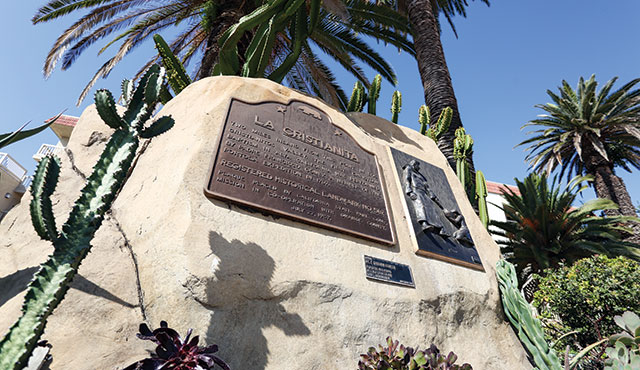One year short of 250 may seem like a very long time, but set against more than 10 millennia, it’s relatively brief.
Case in point: Not long after 1769, life changed quickly and dramatically for the Acjachemen, a Native American tribe that had inhabited what later became California. During the previous 10,000 years, however, their way of life had remained exactly the same.
The cause of this radical change was the Portolá Expedition, the first exploration by Spanish missionaries who headed north seeking to expand New Spain and bring their culture and religion to the New World. And one event 249 years ago will forever stand as a seminal moment in both Catholic and local Native American history: the first baptism of the Acjachemen people.
Many years earlier, the Acjachemen (pronounced “Ah-HAWSH-eh-men”) lived in what is today Orange and San Diego counties. By around 1200 AD, two significant settlements had been established: Panhe, today in the southern end of San Clemente, and Putuidem, a few miles farther to the south. Small and large Acjachemen villages dotted the area. Their territory eventually grew to include what today is Oceanside to Long Beach, east to Lake Elsinore and west to San Clemente and Catalina islands.
Like native peoples throughout history, the Acjachemen lived in harmony with the land and found uses for everything they took from their surroundings. They constructed “kiichas,” circular shelters made of branches, grass and reeds. The hunter-gatherers lived on acorns, wild berries, roots and bulbs, as well as the deer, rabbits and squirrels that thrived in the region.
The first baptism in Alta (“New”) California didn’t take place during Father Junipero Serra’s expedition, says Msgr. Arthur Holquin, Pastor Emeritus of Mission San Juan Capistrano and the Diocese’s Vicar for Divine Worship. “While Father Serra was charged with the evangelization of Alta California, he was not part of the first expedition that left in 1769. There were two padres who were chaplains on this expedition, and one of them, Father Francisco Gomez, performed this first baptism.”
Expedition members first met the Acjachemen tribe while searching for a place to spend one night. The priests were soon informed that two young girls were seriously ill and dying. Fr. Gomez, seeking to help the girls enter heaven, performed the baptism on July 22, 1769. The missionaries later named the area Los Cristianitos (“Little Christians”).
Had the baptism been performed some two centuries later, it would’ve been under the watchful eyes of the United States Marine Corp. A cross and memorial are located at the actual site, off Cristiantos Road, near Camp Pendleton’s Cristiantos entrance. And in 2013, the Casa Romantica Cultural Center and Gardens, in San Clemente, unveiled the official State Historical Marker honoring the baptism. Located near Casa Romantica’s main entrance, it was moved from Camp Pendleton, since visiting the actual site had required Marine approval.
“What this monument represents is the biggest paradigm shift in our culture – the day the children were baptized and we became Christians,” said Teresa Romero, chairwoman of the Juaneño band of Mission Indians, in a 2013 OC Register article. (“Juaneño,” the name given to the Acjachemen people by the Spaniards, was derived from “Mission San Juan Capistrano,” founded by Serra in 1776.)
Last May, San Juan Capistrano’s city council approved the Northwest Open Space Community Parks Project. The 3.6-acre park will include a re-creation of Putuidem, called the “mother village” by the Acjachemen, to honor the first Californians.
After the Mission was established, the Acjachemen way of life was altered dramatically. In order to join the Mission after being baptized, Spanish missionaries and soldiers required that they change nearly everything: their diet and manner of gathering food, their clothing (they had been sparsely clothed in the moderate climate), their culture, their language and their daily activities.
They were also given a new religion.
Although the Acjachemen had devised no written language prior to the Mission’s establishment, tribal elders had passed the tribe’s rich history through stories told to their children. This oral history lived on for thousands of years. Like most Native Americans, the Acjachemen were spiritual people; their view of a higher being was in part based on their intimate coexistence with their natural surroundings.
Twenty-five years after Mission San Juan Capistrano’s founding, more than a thousand Acjachemen had been introduced to Catholicism. They learned about the Bible as the Word of God and His Ten Commandments; about prayer and the existence of the Holy Trinity; and about the earthly life, martyrdom and eternal life of Jesus. Through the generations, more and more Native Americans adopted the Catholic way.
“Most, if not all, were converted to Catholicism,” Msgr. Holquin says. “Whether or not their decedents are still practicing their original faith is difficult to tell, since there has been so much intermarriage, along with other factors. But some definitely do.”
Today most descendants of California’s first inhabitants live as Christians, yet many continue to honor their past by remembering what they’d been taught by their elders many generations ago.

